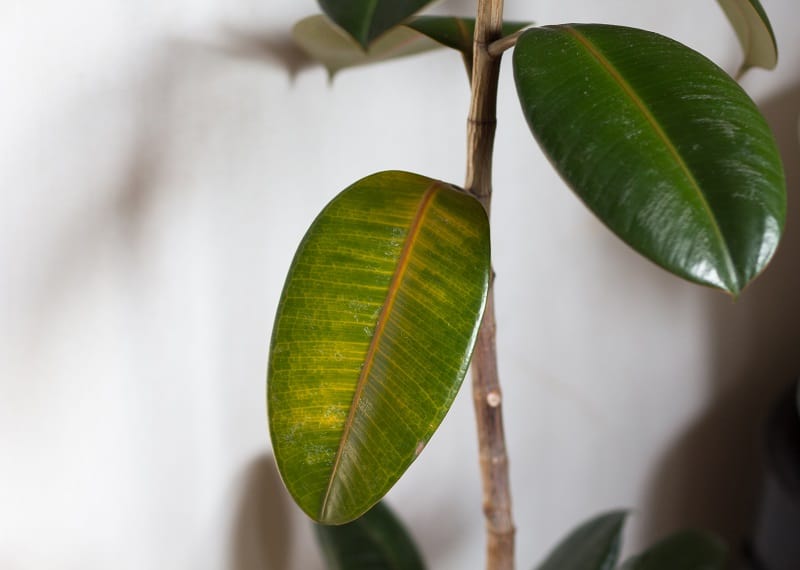
The rubber tree, or rubber fig – scientific name Ficus elastica – is a species of the fig genus. This evergreen tropical tree is native to eastern parts of South Asia and Southeast Asia and has become naturalized in Sri Lanka, the West Indies and Florida in the USA. It is also called rubber bush and Indian rubber tree, and can grow up to 50 feet tall. This hardy plant is easy to care for but also prone to conditions like yellowing leaves.
Common reasons for rubber tree leaves turning yellow
Due to incorrect watering techniques
Rubber tree leaves tend to turn yellow because of overwatering or incorrect watering techniques. Rubber trees, or rubber fig plants, prefer being watered often and placed in a moist environment, but overwatering could lead to negative effects.
To check whether the soil is completely dry, push your fingers into the soil up to the second knuckle. If it feels dry, you need to water your rubber tree. You can also use a moisture probe or tester to determine when to water your plants. Just insert the metal prongs into the soil and a moisture level reading will be given.
Provide enough water for your rubber tree plants, ensuring that the water flows from the drainage holes at the bottom of the planters. Discard any excess water, since these plants do not respond well to wet feet and root rot may ensue. Proper and consistent soil moisture should be maintained since erratic watering schedules could stress your plants.
Due to inadequate drainage holes
Rubber tree leaves may turn yellow if their pots do not have adequate drainage holes. In this case, the roots will sit in water that is trapped in the soil. This could lead to root rot and leaves turning yellow.
To fix this issue, keep your plants in pots with proper drainage holes if they are kept indoors. If you intend to place your rubber tree in a decorative pot with no holes, just plant it in a slightly smaller pot with drainage holes, and then place this pot inside the large decorative pot. Do not forget to take the plant out of the decorative pot when watering it.
Due to incorrect potting mix
The right potting mix is essential for rubber trees to grow strong and healthy. Look for a well-draining mix that enables water to escape from the soil. Opt for a potting mix suitable for house plants, such as those used for succulents.
Mix the potting soil with perlite to encourage aeration and to allow liquids to move easily through the soil. You can also mix in some peat moss to retain the necessary water and keep the soil moist.
Not adjusting the watering schedule with the seasons
Rubber tree leaves could also turn yellow if you fail to adjust your watering schedule according to the changing seasons. Rubber plants need to be watered more often during the summer months when the soil dries out quickly. Wintertime requires less watering since the weather is cooler and there is less sunlight, meaning water and moisture tend to remain longer in the soil.
Due to low humidity levels
Dry soil and low humidity can drastically affect rubber trees and may result in droopy, yellowing leaves. To fix this, mist the leaves more often to increase the humidity.
Due to improper light
Rubber trees thrive when placed in areas with bright, indirect sunlight. It is a bad idea to expose the plants to direct sunlight, as this allows the foliage to burn. If this happens, you need to relocate the plants to another area with indirect light.
Due to pest infestation
Stressed and weakened rubber trees are easy targets for insect infestations. Spider mites and other sap-sucking bugs, like scale insects and mealybugs, drain the plants of moisture, resulting in yellowing leaflets and fronds.
To fix the problem, spray the affected plants with insecticidal soap or insecticide. Neem oil and isopropyl rubbing alcohol are also ideal for controlling and removing pests.
Due to natural causes
If you notice that your rubber tree’s older leaves are yellowing but it also has new growth, the yellowing could be part of the plant’s natural cycle. The older leaves are shed, retaining more energy for the new growth.
Conclusion
Rubber plants are popular ornamentals and indoor plants that add aesthetic value to homes and offices. These plants tend to develop yellow leaves due to improper watering techniques or inadequate drainage holes, as well as due to low humidity levels, incorrect potting mix, or pest infestations.
Image: istockphoto.com / Tatiana Gorbunova